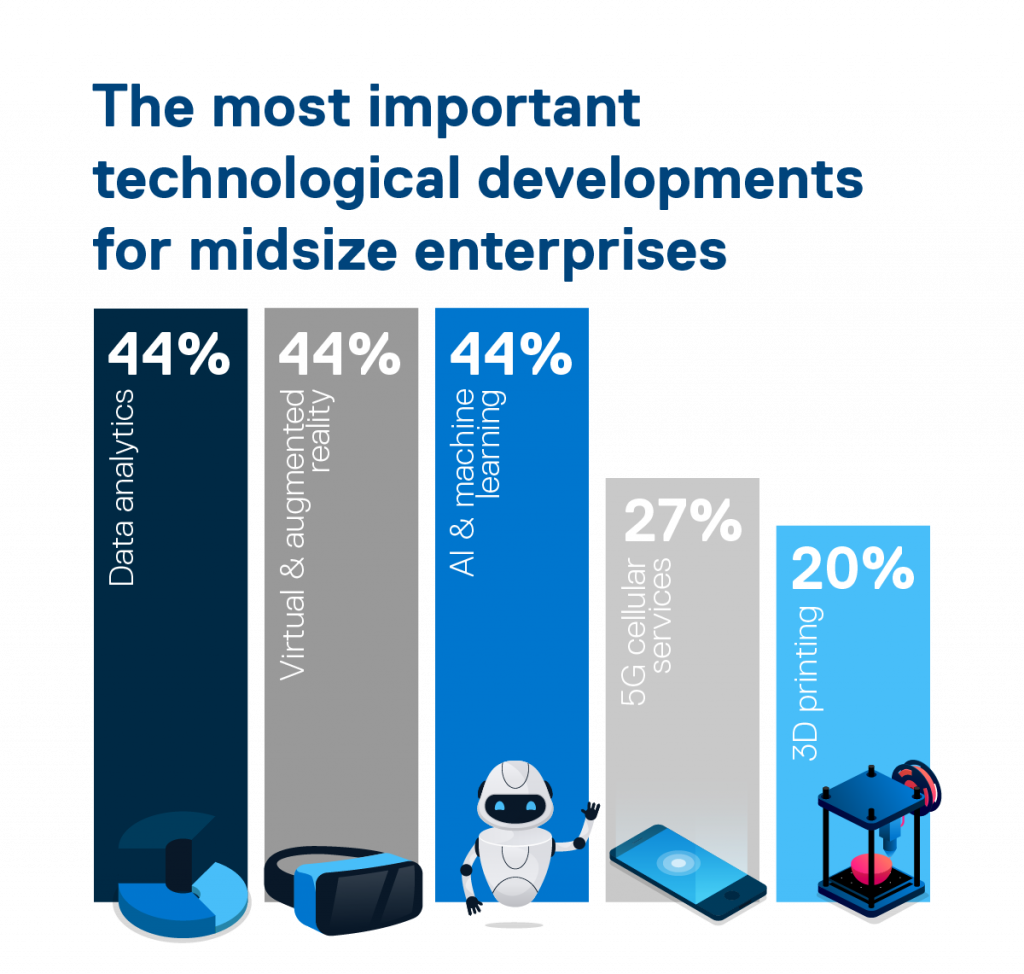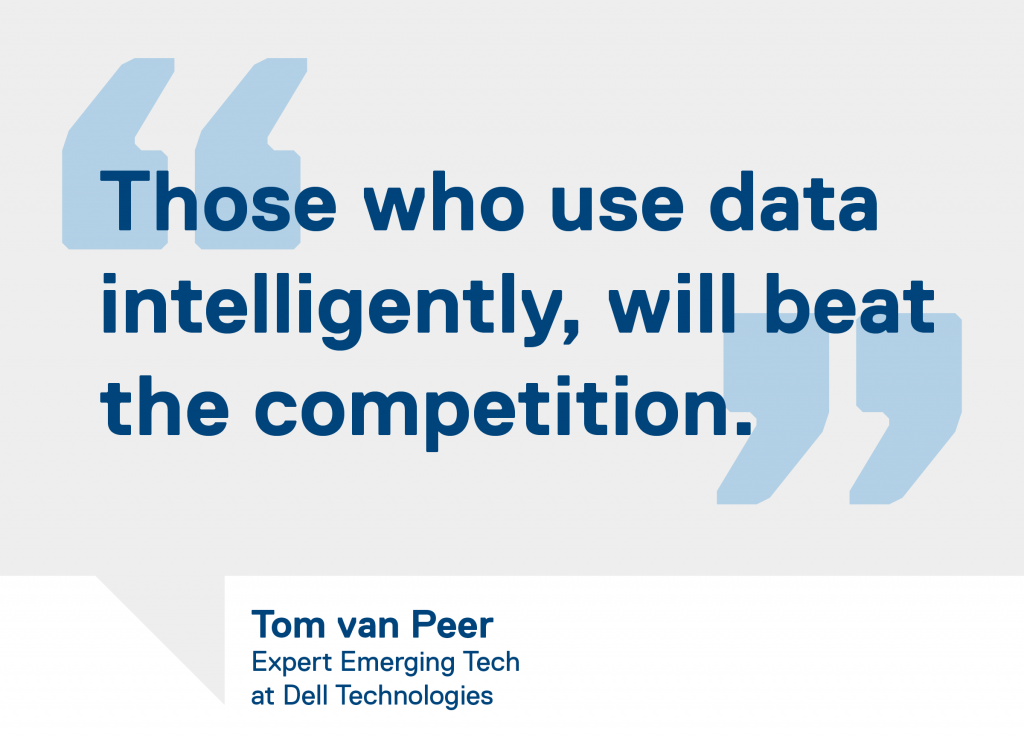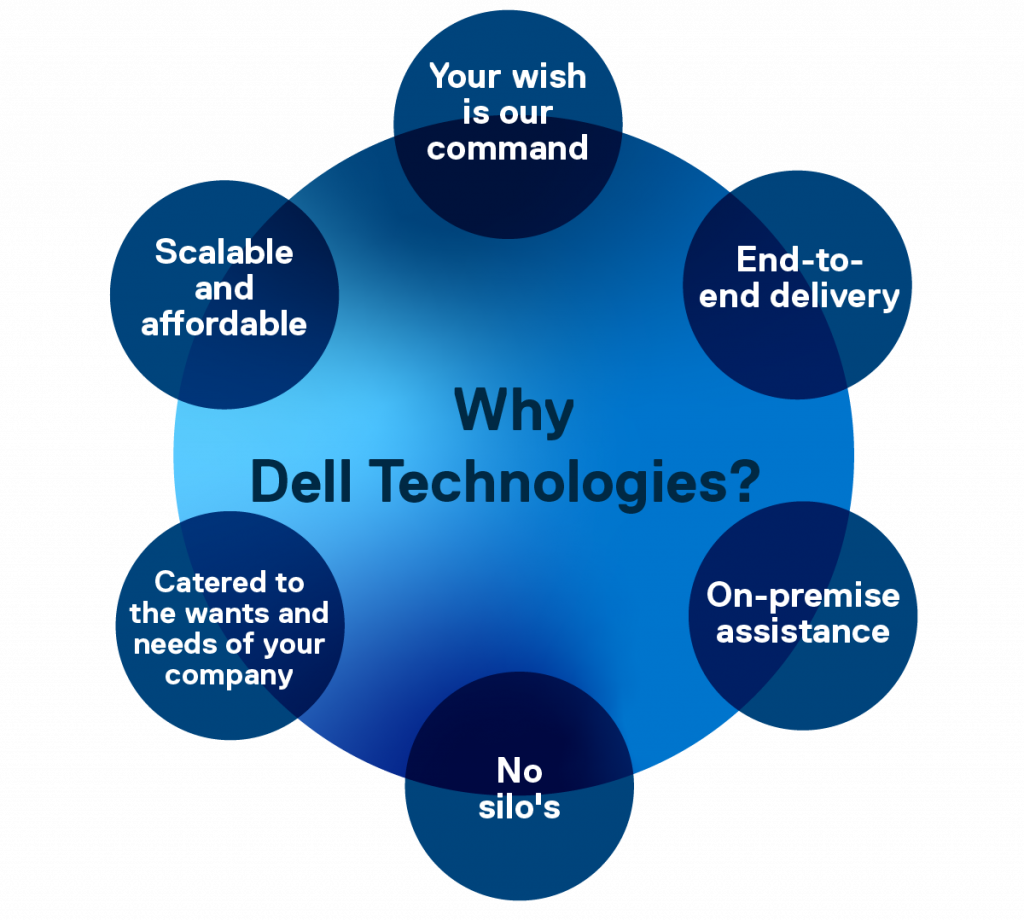Due to our digitization, the range of emerging technologies has grown exponentially. Our pace of innovation is at an all-time high and keeping up is difficult. Two of these emerging technologies, however, are very important: data analytics and AI. If you want to get your company ready for the next decade, a deeper delve into these two new technologies is vital. Research from IDG, commissioned by Dell Technologies, shows that out of all new and emerging technologies, midsize companies find data analysis one of the most important developments, followed closely by AI. In the years to come, these technologies will help you stay ahead of the competition. And yet, the midsize market seems indifferent to them.
Data as a driver for business
“In today’s market, data-analytics should be the driving force of your company,” says Tom van Peer, an expert in emerging tech at Dell Technologies. “Everyone has an interest in storing data. And rightly so. It is your most valuable asset. Now more than ever, data has inherent value. Anyone who uses their data intelligently, stays ahead their competitor.” Van Peer is referring to the use of data as a driver. One that helps you make decisions easier. “Car insurers have been doing so for years. They determine their rates that way. Nowadays, we see similar processes everywhere,” says van Peer. “Take the sale and purchase of certain products. You can use data to predict which products will sell with your customers in the coming weeks, months or even years.”

Another good example are large electronics stores. These megastores adjust their prices in real time because their competition is selling the same product at cheaper rates. All based on data. “These types of stores know that customers check their smartphones to see whether or not they can find their products cheaper elsewhere. A store that is aware of this and offers products at a lower price, tend to attract more customers,” says van Peer. For many midsize web shops this is also beneficial. Data keeps track of purchasing patterns and shows where visitors drop out or which recommendations work really well. You can use this data to improve your web shop’s UX, increase conversion and sell more products.
Data as fuel for AI
Data analysis can already make a huge difference. But partner it with AI and your company will really make a difference, because data is its very fuel. Van Peer: “Although AI is still in its infancy, it’s here to stay. We’ll do things with AI in the next decade that we can only dream about now. People often refer to AI as statistics 2.0, but they’re sorely mistaken. Algorithms are really, really good at predicting things. They tell us what the market, the customer and/or the competitor will do.” In addition, they can properly assess the wants and needs of customers. “Take Netflix or Spotify. Having a fine taste for films or music is no longer a necessity. Their algorithms provide recommendations that cater to the user’s personal taste. All via previously saved viewing or listening patterns: data. It is a great retention strategy, ensuring customers to come back to them.”
So how can medium-sized enterprises benefit from this? “I recently visited a company that develops intelligent machines used in operations. They use artificial intelligence with augmented reality to advise surgeons. If a surgeon needs to make an incision, AI uses AR to indicate the best place to start. It is then up to the surgeon to follow up on that advice or not.” But make no mistake: AI doesn’t randomly conjure up these predictions. Data storage and analysis are essential to that process. These technologies require hours, even days of video data analysis. “To train this specific model, video material from previous operations was analyzed. The data collected allowed the AI to estimate the best course of action.”
The importance of saving data
Whether you work with data analysis, AI or both: data storage is crucial. Van Peer: “Even medium-sized enterprises not working with AI or data analysis now, already need to store as much data as possible. You’ll be able to work with it at a later stage. If you start in time, you don’t have to gather data convulsively when it’s too late. So save up as much as possible starting now.”

This does require some caution and attention, warns van Peer. Firstly, unlimited data hoarding is not allowed. “Keeping GDPR in mind, you need to know what to store ánd what not to store.” In the medical world, for example, there are a lot of rules regarding data storage. “Dutch regulations concerning medical records are very strict. If you don’t pay attention, you will have a lawsuit on your hands.” Of course, you can import data from the US, where rules are different, but even then, you have to be careful. “Suppose you learn an AI model about knee injuries, data from the US will give you false outcomes. There, knee injuries are often the result of obesity,” says van Peer. “An AI will then incorrectly link knee injuries to obesity more often than is actually the case in The Netherlands. You want to prevent situations like that.” In short: those who work with data must be cautious when handling it.
Take IT On
Do you want to get started with data analytics and AI? Dell Technologies is happy to help you. “We do this by sitting down with your IT experts and determining what you need,” says van Peer. In the case of data, the first step is often storage. “We have simple storage solutions, but also solutions that tell you where your data is archived and why it is archived.” The latter is very important when processing large amounts of data. Van Peer: “Compare it to moving. All documents your previous house are stored in the basement with an “old” sticker on it. Documents from the new house get a prominent spot in your office. Our storage solutions work the same.” By virtually tagging your data, it’s easier to identify and find important information. You actually create a system designed for data classification, which ultimately saves space. After all, why would you be interested in very old data?
A solution such as Clarity Now works very well. This organizes your data in a logical way. In addition, it is a good tool to map your unstructured data.

Working with AI
We’re also happy to help you with AI. “To get back to that medical company: we don’t know a whole lot about medical equipment, but we do know a lot about IT. You need GPU’s with sturdy graphics cards to develop artificial intelligence. A company like this buys our hardware, we install the right cards and ensure that proper software is running.” The company then takes over again and their IT experts build the infrastructure. “They know what requirements an AI model must meet for medical purposes, so we lay the groundwork and they build from that.” Here, Dell Technologies can also be of service. “In London we teach IT experts to develop applications that meet their needs. In addition, we work with partners who’ve been building AI models for years. Dell Technologies delivers the tools, tells you how to assemble them and gives you the freedom to set it up how you want it.”
Why Dell Technologies?
Suppose you want to get started with data and AI: why choose Dell Technologies? Van Peer: “What distinguishes us is our single-vendor model. After we come up with a plan, we’ll roll it out, and do so at the customer’s pace. If there’s urgency, we’ll ensure that it is good to go as soon as the following week.” It’s comparable to shopping at your favorite hardware store. When buying a new house, there’s work to be done. Going to a hardware store that has all the stuff you need, is way more convenient than going to one that only has carpentry tools. That’s how we operate at Dell Technologies as well. “Working in silo’s is old fashioned. It’s inconvenient for our customers and for us”, says van Peer. “We love to be as encompassing as possible.”
Download our white paper about the wants and needs of medium-sized enterprises, and what’s at stake in the mid-sized market.
